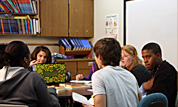What do teachers need to know about students who are learning to speak English?
Page 4: Sheltered Instruction
 It is important to remember that language instruction for ELs should not be restricted to language arts or English as a second language classes. Rather, language instruction should be integrated into all of their content-areas classes. Teachers need to plan language objectives (e.g., learning content-specific vocabulary such as caucus and census) in addition to content-area objectives.
It is important to remember that language instruction for ELs should not be restricted to language arts or English as a second language classes. Rather, language instruction should be integrated into all of their content-areas classes. Teachers need to plan language objectives (e.g., learning content-specific vocabulary such as caucus and census) in addition to content-area objectives.
Sheltered instruction was designed to help English learners to learn English as well as academic content. It can be used:
- By ESL and bilingual teachers in all of the programs outlined on Perspectives & Resources page 3
- By general education teachers
- With students of various levels of English proficiency
Sheltered content instruction utilizes distinct instructional techniques to provide support to help English learners understand demanding lesson content. Not only do teachers plan for objectives that correspond to grade-level standards but they also provide the language objectives necessary for their English learners to express their ideas. Teachers need to be cognizant of their students’ language levels and plan the language objectives accordingly.
| Science Objective | English Language Objective |
| Understand the process of photosynthesis. | Advanced Proficiency: Use complete sentences to orally describe the process of photosynthesis. |
| Intermediate Proficiency: Use identified vocabulary terms to describe the process of photosynthesis. | |
| Beginning Proficiency: Using a diagram, indicate which part of the photosynthesis process the teacher has described. |
For Your Information
The Sheltered Instruction Observational Protocol (SIOP) was developed because no explicit model existed for delivering sheltered instruction, resulting in inconsistent implementation. SIOP, a research-validated framework, provides a standardized approach for delivering sheltered lessons. Rather than selecting random features of sheltered instruction, SIOP requires teachers to systematically and consistently deliver critical features of sheltered instruction. SIOP professional development provides training on lesson planning and instructional delivery and covers eight components of instruction: preparation, building background knowledge, comprehensible input, strategies, interaction, practice and application, lesson delivery, and review and assessment. Greater academic outcomes for EL students are reported when teachers are trained to use the SIOP Model.
Note: For more information about the SIOP model see the Additional Resources and Information section of this module.
Comprehensible Input
Within sheltered instruction, teachers offer comprehensible input—teaching at a level that is just beyond the students’ current level of language competence—while also providing the scaffolded supports necessary to understand the information. For example, when a teacher is teaching a vocabulary lesson to English learners, they may use diagrams or other visual supports to help students learn the new terms. Teachers who provide comprehensible input know how to recognize areas of potential linguistic difficulty and subsequently:
- Monitor their speech
- Model what they want the student to do
- Use a variety of modalities in their instruction
Leonard Baca, former Director of the BUENO Center for Multicultural Education, talks about the interconnection between comprehensible input and various aspects of language (time: 1:07).

Leonard Baca, EdD
School of Education
University of Colorado at Boulder
Transcript: Leonard Baca, EdD
Various aspects of language are all interconnected. So whether it’s listening, speaking, reading, and writing, they’re all part of the whole-language development process. In working with English language learners, the teacher has to keep in mind that each of them has to have emphasis, and that each of them depend on the other for optimal development. So the more practice students have with all of these aspects…but especially the oral language piece, because the oral language obviously is what they hear first and what they begin to understand. The big point that many authors, especially Steven Krashen, make as well as Vygotsky, is the idea of the zone of proximal development. When you’re looking at English language development, that same principle applies. Krashen emphasizes the importance of comprehensible input in the English language. And that applies not only to the oral aspects but to the reading as well as the writing parts of it.
The table below describes some ways teachers can support EL students’ comprehension.

Supports for Comprehensible Inputx
syntax The grammatical arrangement of words in a sentence. |
||||
| Speak more slowly | Speak clearly | Monitor vocabulary | Use multimodal techniques | Simplify syntax |
|
Use longer pauses between sentences and ideas. Use a natural pace rather than a slow, exaggerated one. |
Limit the use of contractions or fused forms (e.g., use want to rather than wanna). Stress key words to support meaning. |
Use high-frequency words. Explain unfamiliar terms. Use cognates. Limit the use of idioms, slang, pronouns, and vague referents. |
Use objects, pictures, labeled diagrams, and videos. Infuse demonstration throughout lessons. Use gestures, body language movement, and role playing. |
Keep sentences short. Keep clauses short. |
cognates
Words that sound similar in two languages and have the same meaning (e.g., fantastic in English and fantástico in Spanish).
Students might already know what comunidad means in Spanish, so that the teacher only needs to point out that comunidad is a cognate for the word community. On the other hand, students might not know what democracia means in Spanish, so that merely pointing out that democracia is a cognate for democracy would not be sufficient. Students need to learn what democracy means.
Note: Be aware of false cognates––words that look similar in two languages but actually have different meanings. For example, embarazada in Spanish means pregnant and does not mean embarrassed, as one might think.
idioms
Words and phrases that have meanings different from the literal one. For example, skinny minute and raining cats and dogs.
referents
Words that are used to represent other words. For example, “Bring me the thing (i.e., the book) that is on the desk.”
Keep in Mind
To support skill development, new vocabulary can be previewed in the home language, taught in English, and reviewed again in the student’s home language.
View the following video to see a teacher providing a lesson without using sheltered instruction (time: 1:33).
Transcript: Lesson Not Using Sheltered Instruction
Teacher: Okay, class, today we are going to be talking about making healthy food choices for a healthy lifestyle. This poster shows a picture of a plate. It is called My Plate, and it is a guide that shows people how to eat in healthy ways. MyPlate shows that healthy foods are categorized into five different groups. Each food group is represented by a different color. Grains are in the orange group. Vegetables are in the green group. Fruits are in the red group. Dairy is represented by the blue group. And, last, we have protein, which is the purple group. We should eat foods from all of the five groups every day. The sections in the plate are different sizes. The bigger the section, the more of that food group we should eat. The green section for vegetables, for example, is bigger than the protein section. That means you should eat more vegetables than protein in a day. It’s important to vary your vegetables. You can eat them raw or cooked, canned or frozen. So who in here had vegetables with their dinner last night? Yeah?
Now watch the video to see the teacher providing the same lesson but this time using sheltered instruction (time: 2:38).
Transcript: Lesson Using Sheltered Instruction
Teacher: Okay, class, today we are going to talk about making food choices for a healthy lifestyle. This poster shows a picture of a plate. MyPlate. Mi Plato. It’s a guide that shows people how to eat in a healthy way. Mi Plato shows that healthy foods are categorized into five different groups Five different groups. Each food group is represented by a different color.
We have the grains group, which is the orange group:
Grains
Granos
Grains
Granos
Next, we have the green group, which is the vegetable group:
Vegetables
Vegetales
Vegetables
Vegetales
The vegetable group.
Next, we have the fruit group, which is represented in red:
Fruit
Fruta
Fruit
Fruta
The blue group is the dairy group:
productos lacteos
The dairy group.
And, finally, we have the protein group, which is represented in purple:
Protein
Proteina
Protein
Proteina
We should eat foods from all of the five food groups every day. The sections of the plate are different sizes. The bigger the section, the more food from that section we should eat each day. For example, the green group, the vegetables group, is bigger than the protein group, the purple group, so that means we should eat more vegetables in a day than protein. It’s important to vary your vegetables. You can eat them raw or cooked, canned or frozen. So who in here had vegetables with their dinner last night?
Activity
1. Having watched the demonstration of sheltered instruction above, can you identify some of the instructional supports used by the teacher?
- Used some of the vocabulary words in Spanish.
- Wrote vocabulary in English and Spanish on index cards.
- Used real objects to help students to learn vocabulary terms.
- Provided multiple pictures to illustrate information taught in the lesson.
2. What other instructional supports could the teacher have used during her lesson? Select the link to find out what additional supports the teacher used after collaborating with the school’s bilingual educator.
- Brings in sample foods familiar to EL students (e.g., tortillas, beans).
- Uses free, interactive computer activities available on food pyramid websites that help students categorize foods into groups.
- Displays a mini poster of the MyPyramid in Spanish
- Sends home a worksheet in both English and Spanish about ways families can eat healthy and stay physically active.
- Keeps data on a chart to help students track how their food choices match up to dietary recommendations.
- Checks out library books about healthy eating that are published in Spanish.
Culturally Responsive Instruction
In addition to sheltered instruction, teachers should provide instruction in a culturally responsive way. When doing so, teachers access their students’ cultural knowledge, prior experiences (e.g., personal, cultural, academic), and interests during lessons. When providing culturally responsive instruction, teachers accept, acknowledge, and value their students’ differences, thereby increasing their students’ success in the classroom. Look at the list below to see some of the things a teacher can do to promote culturally responsive instruction. Select from the drop-down menu to learn more about each.
 Studies show that students generally rise or fall to the level of teacher expectations. When teachers believe in their students, students believe in themselves. Teachers who hold high expectations for their English learners generally offer exciting instruction and explicit explanations about concepts. They call on students often and allow them adequate time to respond, and they provide frequent and informative feedback and praise.
Studies show that students generally rise or fall to the level of teacher expectations. When teachers believe in their students, students believe in themselves. Teachers who hold high expectations for their English learners generally offer exciting instruction and explicit explanations about concepts. They call on students often and allow them adequate time to respond, and they provide frequent and informative feedback and praise.
 By practicing culturally responsive instruction, teachers make academic information relevant to their students. There are a number of ways to go about this. Teachers could utilize a network of people from various background and cultural experiences (e.g., families, business people, community members) to act as guest speakers to help motivate and support student learning. Teachers should also vary their instructional techniques to better reflect their students’ cultural practices. For example, rather than requiring all students to participate in an individually based competitive activity––a form of interaction that is not valued in some cultures––a teacher might instead allow students to work in collaborative groups, thus reinforcing the community-centered focus of some cultures.
By practicing culturally responsive instruction, teachers make academic information relevant to their students. There are a number of ways to go about this. Teachers could utilize a network of people from various background and cultural experiences (e.g., families, business people, community members) to act as guest speakers to help motivate and support student learning. Teachers should also vary their instructional techniques to better reflect their students’ cultural practices. For example, rather than requiring all students to participate in an individually based competitive activity––a form of interaction that is not valued in some cultures––a teacher might instead allow students to work in collaborative groups, thus reinforcing the community-centered focus of some cultures.
 In culturally mediated instruction, teachers help their students understand that there are multiple ways to interpret information (e.g., statements, events, actions). Teachers should encourage their students to be active participants in learning by sharing viewpoints based on their cultural backgrounds. In this way, students learn to recognize the value of different and differing opinions. Teachers should also challenge their students to question their own beliefs and actions. During culturally mediated instruction, it is important for teachers not to dismiss students’ contributions, even when they seem off-topic.
In culturally mediated instruction, teachers help their students understand that there are multiple ways to interpret information (e.g., statements, events, actions). Teachers should encourage their students to be active participants in learning by sharing viewpoints based on their cultural backgrounds. In this way, students learn to recognize the value of different and differing opinions. Teachers should also challenge their students to question their own beliefs and actions. During culturally mediated instruction, it is important for teachers not to dismiss students’ contributions, even when they seem off-topic.
 Teachers should facilitate learning by helping their students to do more than simply repeat factual information. Teachers can support student learning by allowing them multiple opportunities to participate in classroom discussion and by encouraging them to explore and share their own perspectives. Teachers can facilitate learning, not by monopolizing the communicative exchanges with their students or dominating lessons, but instead by playing the part of guides, mentors, and consultants.
Teachers should facilitate learning by helping their students to do more than simply repeat factual information. Teachers can support student learning by allowing them multiple opportunities to participate in classroom discussion and by encouraging them to explore and share their own perspectives. Teachers can facilitate learning, not by monopolizing the communicative exchanges with their students or dominating lessons, but instead by playing the part of guides, mentors, and consultants.
 During student-centered instruction, teachers should encourage a learning atmosphere that is cooperative, collaborative, and community oriented. In some cases, students direct their own learning by selecting topics they are interested in, including culturally and socially relevant subjects. Instruction that is student-centered helps students to become self-confident and more likely to express their ideas.
During student-centered instruction, teachers should encourage a learning atmosphere that is cooperative, collaborative, and community oriented. In some cases, students direct their own learning by selecting topics they are interested in, including culturally and socially relevant subjects. Instruction that is student-centered helps students to become self-confident and more likely to express their ideas.
Teachers can optimize their culturally responsive instruction by critiquing their own thoughts and instructional practices to ensure they do not reflect prejudicial attitudes. They can counter traditional teaching practices that reflect middle-class, European-American cultural values by incorporating instruction that infuses a wider range of cultural influences.